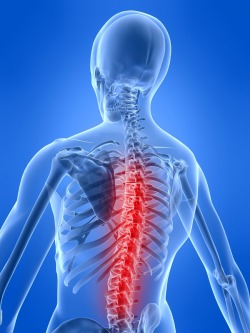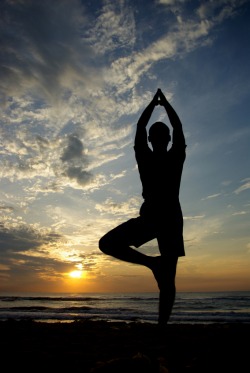Lower Back Pain Causes
It seems almost anything can cause lower back pain. Up to 90% of Americans will complain to their doctor about back pain at some point in their lives and of those, as much as 85% will never be able to determine a cause. It can be the result of poor lifting technique, bad posture, awkward sleeping positions or age.
Of all the lower back pain causes, a lumbar strain is among the most common. It is a microscopic tear or pull of the muscle, ligament or tendon in your lumbar, or lower back, region. It often occurs during heavy lifting or strenuous exercise.
Pain from a lumbar strain can last from a couple of weeks up to several months. It is recommended that you see a back pain specialist if your pain lasts more than a few weeks and does not respond to pain-relieving exercises or positions.
Of all the lower back pain causes, a lumbar strain is among the most common. It is a microscopic tear or pull of the muscle, ligament or tendon in your lumbar, or lower back, region. It often occurs during heavy lifting or strenuous exercise.
Pain from a lumbar strain can last from a couple of weeks up to several months. It is recommended that you see a back pain specialist if your pain lasts more than a few weeks and does not respond to pain-relieving exercises or positions.
Other Lower Back Pain Causes

Another common lower back pain cause is a herniated disc. Also called a slipped or ruptured disc, a herniated disc is often caused by some of the same activities that cause a lumbar strain, making them difficult to distinguish at times.
Your spinal column is made of 33 bones called vertebrae, all stacked one on top of the other. Among other uses, these vertebrae are designed to protect your spinal cord from injury and impact. Since bone is a hard, ridged material, there are soft cushions between the vertebrae to give your spine some flexibility. These cushions are called discs. Within the discs is a gel-like substance and when the spine is compressed, the gel can squeeze through, rupturing the disc much like a flattened jelly donut. The oozing gel can put pressure on nerves, causing pain.
A ruptured disc often requires medical attention although there are some treatments available that focus on the muscle in your lower back and have proven to reduce and even eliminate back pain without extensive medical treatment. See our free report for more information.
Sciatica occurs when a bone, muscle or herniated disc encroaches on the sciatic nerve. Your sciatic nerve is the largest nerve in your body and stems from your lower back, around your buttocks and down the entire length of each leg. A disc, for example, can rupture and apply pressure on your sciatic nerve and because your nerve runs down the length of your leg, the pain may not be felt in your back at all, but in any location from your buttocks to your foot. Often people who suffer from sciatica complain of leg pain and may not realize that the pain is due to a pinching or encroachment of the sciatic nerve in their lumbar region.
Exercises and loosening stretches are usually prescribed for sciatica. Many people suffering from sciatica have experienced relief by re-conditioning the muscles in their lower back and by corrective posture techniques.
There are many, many lower back pain causes, some of which can be dangerous and even life-threatening. When in doubt, it is always advisable to see a back pain specialist when you experience lower back pain in order to rule out any serious conditions.
Other lower back pain causes include kidney infection and kidney stones, spondylolysis, degenerative disc disease (DDD), osteoarthritis, bone spurs, spinal stenosis, fibromyalgia, discitis, pagets disease, spinal bifida and scoliosis among others.
Your spinal column is made of 33 bones called vertebrae, all stacked one on top of the other. Among other uses, these vertebrae are designed to protect your spinal cord from injury and impact. Since bone is a hard, ridged material, there are soft cushions between the vertebrae to give your spine some flexibility. These cushions are called discs. Within the discs is a gel-like substance and when the spine is compressed, the gel can squeeze through, rupturing the disc much like a flattened jelly donut. The oozing gel can put pressure on nerves, causing pain.
A ruptured disc often requires medical attention although there are some treatments available that focus on the muscle in your lower back and have proven to reduce and even eliminate back pain without extensive medical treatment. See our free report for more information.
Sciatica occurs when a bone, muscle or herniated disc encroaches on the sciatic nerve. Your sciatic nerve is the largest nerve in your body and stems from your lower back, around your buttocks and down the entire length of each leg. A disc, for example, can rupture and apply pressure on your sciatic nerve and because your nerve runs down the length of your leg, the pain may not be felt in your back at all, but in any location from your buttocks to your foot. Often people who suffer from sciatica complain of leg pain and may not realize that the pain is due to a pinching or encroachment of the sciatic nerve in their lumbar region.
Exercises and loosening stretches are usually prescribed for sciatica. Many people suffering from sciatica have experienced relief by re-conditioning the muscles in their lower back and by corrective posture techniques.
There are many, many lower back pain causes, some of which can be dangerous and even life-threatening. When in doubt, it is always advisable to see a back pain specialist when you experience lower back pain in order to rule out any serious conditions.
Other lower back pain causes include kidney infection and kidney stones, spondylolysis, degenerative disc disease (DDD), osteoarthritis, bone spurs, spinal stenosis, fibromyalgia, discitis, pagets disease, spinal bifida and scoliosis among others.
Lower Back Pain Treatment

Treatment for lower back pain usually depends on the type of injury, but in many cases, a couple of days bed rest may be in order. Specialists almost never recommend more than two days, however, as too much rest can make a condition worse. The muscles need to move in order to recuperate and movement can only take place out of bed. If you are resting due to back pain, try to get up and walk around every hour or so, even if it hurts.
In most situations, back pain will go away within a month or two, regardless of treatment. This means that exercise and stretching techniques may make no difference in one’s recovery period. Therefore, exercise and stretching during recovery is recommended only if it makes the patient more comfortable. Exercise then, is up to the patient. This should not be confused with movement, however. It is advisable that a balance of movement and rest should be undertaken through recovery. Some patients will rest their lower back by lying on the floor with their feet propped on a pillow or chair, relieving the stress on their lower back. After a while, those patients will resume normal activity, moving and bending as they normally would until their discomfort was painful enough that they returned to lying on their back. Regardless of treatment, do not under-estimate the power of movement.
The most important remedy for back pain is preventive exercise and corrective posture. Eliminating back pain is best done before the pain occurs. This means making lower back exercises a part of one’s daily workout. If a muscle balance program was established, combined with improved posture therapy, many people who suffer from lower back pain could eliminate their discomfort completely once and for all. For more information about treatment, see our free report.
In most situations, back pain will go away within a month or two, regardless of treatment. This means that exercise and stretching techniques may make no difference in one’s recovery period. Therefore, exercise and stretching during recovery is recommended only if it makes the patient more comfortable. Exercise then, is up to the patient. This should not be confused with movement, however. It is advisable that a balance of movement and rest should be undertaken through recovery. Some patients will rest their lower back by lying on the floor with their feet propped on a pillow or chair, relieving the stress on their lower back. After a while, those patients will resume normal activity, moving and bending as they normally would until their discomfort was painful enough that they returned to lying on their back. Regardless of treatment, do not under-estimate the power of movement.
The most important remedy for back pain is preventive exercise and corrective posture. Eliminating back pain is best done before the pain occurs. This means making lower back exercises a part of one’s daily workout. If a muscle balance program was established, combined with improved posture therapy, many people who suffer from lower back pain could eliminate their discomfort completely once and for all. For more information about treatment, see our free report.